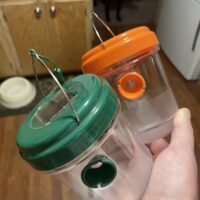Steps for Cleaning a Hummingbird Feeder
Sugar water feeders are an easy way for backyard birders to attract more hummingbirds, but it’s important to clean the feeders to keep birds healthy. In general, the best advice on how to clean a hummingbird feeder is to follow the same general steps that you would for cleaning seed feeders. This means taking the feeders down, emptying any leftover sugar water, and scrubbing them with hot water and dish soap. You can also use a bleach solution (made from 1 part bleach to 9 parts water) or a vinegar solution (1 part vinegar to 2 parts water). Make sure you rinse all parts thoroughly with clean water before refilling them.
You’ll need to clean hummingbird feeders more frequently than other feeders. Aim to scrub them once a week in cooler weather and twice a week when temperatures soar. If you’re crunched for time, Emma Grieg, project leader for the Cornell Lab of Ornithology’s Project FeederWatch, has a tip. “Running them through a dishwasher will do the trick,” she says.
Droll Yankees Cleaning Brushes
When washing the feeders by hand, pay special attention to the feeding ports. A pipe cleaner can help get the ports squeaky clean, as can special microbrushes. Use this three-pack of little brushes to scrub tiny ports on sugar-water feeders.
